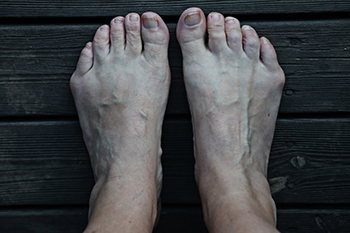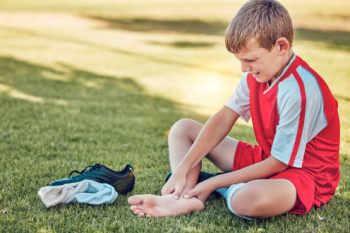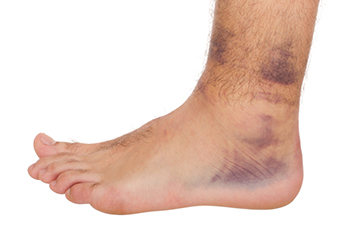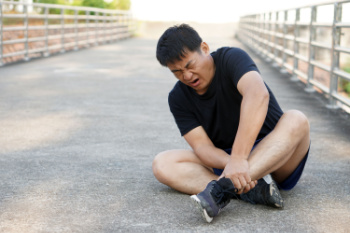Connect With Us
Blog
Items filtered by date: December 2020
Bunions
A bunion is a bump that forms at the base of the big toe. Bunions form when the big toe pushes against the next toe, which forces the big toe joint to get bigger and stick out. As a result, the skin over the bunion may start to appear red and it may feel sore.
There are risk factors that can increase your chances of developing bunions. People who wear high heels or ill-fitting shoes are more likely to develop them, in addition to those who have a genetic history of bunions or have rheumatoid arthritis.
The most obvious way to tell if you have a bunion is to look for the big toe pushing up against the toe next to it. Bunions produce a large protrusion at the base of the big toe and may or may not cause pain. Other symptoms are redness, swelling, and restricted movement of the big toe if you have arthritis.
Nonsurgical methods are frequently used to treat bunions that aren’t severe. Some methods of nonsurgical treatment are orthotics, icing and resting the foot, taping the foot, and pain medication. Surgery is usually only required in extreme cases. However, if surgery is needed, some procedures may involve removing the swollen tissue from around the big toe joint, straightening the big toe by removing part of the bone, or joining the bones of your affected joint permanently.
Your podiatrist will diagnose your bunion by doing a thorough examination of your foot. He or she may also conduct an x-ray to determine the cause of the bunion and its severity.
What is a Tailor’s Bunion?
 A tailor's bunion, also known as a bunionette, is a bony protrusion on the outside of the foot near the base of the little toe. This condition occurs due to the misalignment of the fifth metatarsal bone, often caused by inherited structural abnormalities, wearing tight or ill-fitting shoes, or repetitive stress on the foot. Unlike the more well-known bunion, which affects the inside of the foot at the base of the big toe, a tailor's bunion affects the outer side of the foot. Both conditions can cause pain, swelling, and redness, but a tailor's bunion specifically impacts the small toe area. To manage a tailor's bunion, wear properly fitting shoes with a wide toe box, use padding to reduce pressure, and consider orthotic inserts for better foot alignment. Non-surgical treatments, such as anti-inflammatory medications can alleviate symptoms. In severe cases, surgery may be required to correct the deformity. Proper diagnosis is essential, as tailor's bunions can be confused with other issues like hammertoes or arthritis. For an accurate diagnosis and effective treatment, it is suggested that you visit a podiatrist.
A tailor's bunion, also known as a bunionette, is a bony protrusion on the outside of the foot near the base of the little toe. This condition occurs due to the misalignment of the fifth metatarsal bone, often caused by inherited structural abnormalities, wearing tight or ill-fitting shoes, or repetitive stress on the foot. Unlike the more well-known bunion, which affects the inside of the foot at the base of the big toe, a tailor's bunion affects the outer side of the foot. Both conditions can cause pain, swelling, and redness, but a tailor's bunion specifically impacts the small toe area. To manage a tailor's bunion, wear properly fitting shoes with a wide toe box, use padding to reduce pressure, and consider orthotic inserts for better foot alignment. Non-surgical treatments, such as anti-inflammatory medications can alleviate symptoms. In severe cases, surgery may be required to correct the deformity. Proper diagnosis is essential, as tailor's bunions can be confused with other issues like hammertoes or arthritis. For an accurate diagnosis and effective treatment, it is suggested that you visit a podiatrist.
If you are suffering from bunion pain, contact Alice Kim, DPM of 101 Foot and Ankle. Our doctor can provide the care you need to keep you pain-free and on your feet.
What Is a Bunion?
Bunions are painful bony bumps that usually develop on the inside of the foot at the joint of the big toe. As the deformity increases over time, it may become painful to walk and wear shoes. Women are more likely to exacerbate existing bunions since they often wear tight, narrow shoes that shift their toes together. Bunion pain can be relieved by wearing wider shoes with enough room for the toes.
Causes
- Genetics – some people inherit feet that are more prone to bunion development
- Inflammatory Conditions - rheumatoid arthritis and polio may cause bunion development
Symptoms
- Redness and inflammation
- Pain and tenderness
- Callus or corns on the bump
- Restricted motion in the big toe
In order to diagnose your bunion, your podiatrist may ask about your medical history, symptoms, and general health. Your doctor might also order an x-ray to take a closer look at your feet. Nonsurgical treatment options include orthotics, padding, icing, changes in footwear, and medication. If nonsurgical treatments don’t alleviate your bunion pain, surgery may be necessary.
If you have any questions, please feel free to contact our office located in Camarillo, CA . We offer the newest diagnostic and treatment technologies for all your foot care needs.
Sever's Disease
Sever's disease, also known as calcaneal apophysitis, is a medical condition that causes heel pain in children’s feet while they’re growing. Sever's disease occurs most commonly in boys and girls between the ages of 8 and 14.
Sever's disease occurs when the child’s growth plate, or the calcaneal epiphysis, an area attached to the Achilles tendon, is injured or when the muscles and tendons of the growing foot do not keep pace with bone growth. The result is constant pain experienced at the back of the heel and the inability to put any weight on the heel. This forces the child to bear weight on their toes while walking. When a toe gait develops, the child must change the way they walk to avoid placing weight on the painful heel. If this is not properly addressed, this can lead to further developmental problems.
The most common symptom of Sever's disease is acute pain felt in the heel when a child engages in physical activity such as walking, jumping or running. Children who are active athletes are among the group most susceptible to experiencing Sever's disease. This is due to the extreme stress and tension placed on their growing feet. The rolling movement of the foot during walking or running and obesity are both additional conditions linked to causing Sever's disease.
The first step in treating Sever's disease is to rest the foot and leg and avoid physical activity. Over the counter pain-relieving and anti-inflammatory medications can be helpful for reducing the amount of heel pain. A child with Sever's disease should also wear shoes that properly support the heel and the arch of the foot. Consider purchasing orthotic shoe inserts which can help support the heel and foot while it is healing. Most patients with Sever's disease symptoms report an eventual elimination of heel pain after wearing orthotic insoles that support the affected heel.
Sever's disease may affect either one heel or both. It is important for a child experiencing heel pain to be examined by a foot doctor who can apply the squeeze test. The squeeze test compresses both sides of the heel in order to determine if there is intense pain. Discourage any child diagnosed with Sever's disease from going barefoot as this can intensify the problem. Apply ice packs to the affected painful heel two or three times a day for pain relief.
Exercises that help stretch the calf muscles and hamstrings are effective at treating Sever's disease. An exercise known as foot curling has also proven to be very effective at treating Sever's disease. When foot curling, the foot is pointed away from the body, then curled toward the body to help stretch the muscles. The curling exercise should be done in sets of 10 or 20 repetitions and repeated several times throughout the day.
Treatment methods can continue for at least 2 weeks and as long as 2 months before the heel pain completely disappears. A child can continue doing daily stretching exercises for the legs and feet to prevent Sever’s disease from returning.
Heel Pain in Your Child

Heel pain in children can be concerning for parents, especially when it interrupts their child's active lifestyle. One common cause of heel pain is Sever's disease, also known as calcaneal apophysitis. Typically affecting children aged eight to 12 during periods of rapid growth, Sever's disease is characterized by pain or tenderness in one or both heels, often worsened by physical activity. Symptoms may include mild swelling surrounding the heel bone and limping, especially after exercise. The underlying cause lies in growth spurts where bones, muscles, and tendons grow and change quickly. This makes the growth plate in the heel more susceptible to injury. The Achilles tendon, in particular, can become tight as the bones in the lower leg grow, adding stress to the heel’s growth plate. Activities like running and jumping, especially when combined with wearing sports shoes with studs, can increase the risk. While Sever's disease does not typically lead to long-term problems, it is important to manage the symptoms to prevent disruption in daily activities. Encouraging rest and avoiding activities that cause pain can help alleviate symptoms. If your child exhibits or complains of heel pain, it is suggested that you schedule an appointment with a podiatrist for an exam and treatment.
Sever's disease often occurs in children and teens. If your child is experiencing foot or ankle pain, see Alice Kim, DPM from 101 Foot and Ankle. Our doctor can treat your child’s foot and ankle needs.
Sever’s Disease
Sever’s disease is also known as calcaneal apophysitis, which is a medical condition that causes heel pain I none or both feet. The disease is known to affect children between the ages of 8 and 14.
Sever’s disease occurs when part of the child’s heel known as the growth plate (calcaneal epiphysis) is attached to the Achilles tendon. This area can suffer injury when the muscles and tendons of the growing foot do not keep pace with bone growth. Therefore, the constant pain which one experiences at the back of the heel will make the child unable to put any weight on the heel. The child is then forced to walk on their toes.
Symptoms
Acute pain – Pain associated with Sever’s disease is usually felt in the heel when the child engages in physical activity such as walking, jumping and or running.
Highly active – Children who are very active are among the most susceptible in experiencing Sever’s disease, because of the stress and tension placed on their feet.
If you have any questions, please feel free to contact our office located in Camarillo, CA . We offer the newest diagnostic and treatment technologies for all your foot and ankle injuries.
Are You Suffering From Nerve Damage?
Ankle Sprains
Although ankle sprains may not be as serious as a broken ankle, they should be given immediate attention and care. An ankle sprain can lead to a significant amount of pain, as well as limited mobility. They are often characterized by the swelling and discoloration of the skin. This occurs when the ligaments are stretched beyond their limits.
The simple act of walking can sometimes cause a sprain, which makes ankle sprains a very common injury that can happen to anyone. They occur when the ankle twists in an awkward way or rolls over itself, causing a pop or snap in the tendons around the ankle. Some people are more at risk than others. These include athletes who continually push their bodies to the limits and also people who have previously suffered accidents to the feet, ankles, or lower legs.
Most of the time, an ankle sprain is not severe enough for hospital attention. There are many at-home treatment options available, including propping the leg up above your head to reduce blood flow and inflammation, applying ice packs to the affected area as needed, taking over-the-counter pain relievers and anti-inflammatory medication, using an ACE bandage to wrap and support the injured ankle, and most importantly, remaining off your feet until the ankle has fully healed.
Despite this, an ankle sprain can turn into a severe injury that might require hospitalization. If the ankle ligaments or muscles are damaged from a tear or rip, that is one sign that the sprain is severe enough for hospital attention and possibly for surgery. Even after the surgery, the recovery process can be long. You may need to have rehabilitation sessions administered by your podiatrist to get your ankle back to full health.
The severity of your sprain might become apparent if you are unable to stand or walk, consistent pain occurs over a prolonged period of time, swelling is much more severe than initially present, or if you start to experience tingling or numbness. These signs may indicate that your ankle sprain might actually be a broken ankle, an injury that requires immediate medical attention.
Although they are not completely avoidable, ankle sprains can be curbed with some preventative treatment measures. These include wearing appropriate-fitting shoes that not only provide a comfortable fit, but also ankle support. It is also recommended to stretch before doing any kind of physical activity, as this will help lower your body’s chance for an injury.
Three Types of Ankle Sprains

Ankle sprains are common injuries classified into three types based on their degree and severity. A first-degree sprain is the mildest form, involving slight stretching or microscopic tearing of the ligament fibers. Symptoms include mild pain, swelling, and stiffness, with little to no instability in the ankle joint. A second-degree sprain is more severe, characterized by partial tearing of the ligament. This type results in moderate pain, swelling, and bruising, with some difficulty bearing weight and noticeable instability in the ankle. The most severe is a third-degree sprain, where the ligament is completely torn. This causes significant pain, swelling, and bruising, in addition to a substantial loss of function and stability in the ankle. Recovery times vary depending on the severity, with mild sprains healing within a few weeks and severe sprains potentially taking several months. If you have suffered a sprained ankle, it is suggested that you consult a podiatrist who can determine what type of sprain you have endured, and offer correct treatment for it.
Ankle sprains are common but need immediate attention. If you need your feet checked, contact Alice Kim, DPM from 101 Foot and Ankle. Our doctor can provide the care you need to keep you pain-free and on your feet.
How Does an Ankle Sprain Occur?
Ankle sprains take place when the ligaments in your ankle are torn or stretched beyond their limits. There are multiple ways that the ankle can become injured, including twisting or rolling over onto your ankle, putting undue stress on it, or causing trauma to the ankle itself.
What Are the Symptoms?
- Mild to moderate bruising
- Limited mobility
- Swelling
- Discoloration of the skin (depending on severity)
Preventing a Sprain
- Wearing appropriate shoes for the occasion
- Stretching before exercises and sports
- Knowing your limits
Treatment of a Sprain
Treatment of a sprain depends on the severity. Many times, people are told to rest and remain off their feet completely, while others are given an air cast. If the sprain is very severe, surgery may be required.
If you have suffered an ankle sprain previously, you may want to consider additional support such as a brace and regular exercises to strengthen the ankle.
If you have any questions please feel free to contact our office located in Camarillo, CA . We offer the newest diagnostic and treatment technologies for all your foot and ankle needs.
Sports Related Foot And Ankle Injuries
Foot and ankle injuries are common among people who participate in sports. Several factors contribute to this. They include failing to stretch or warm up properly, not wearing the proper type of shoe and not taping or providing other types of support for the ankle or foot. The most common foot and ankle injuries suffered by people involved in sports are plantar fasciitis, ankle sprains and Achilles tendon damage or ruptures. If not treated properly, they can lead to permanent disability.
Treating these injuries is relatively simple if they are identified and addressed early. Many athletes dismiss the initial aches and pains associated with injury as just soreness or tired muscles. Their first response is usually to try to work through it. This can lead to serious problems. Many minor injuries are made far more serious when athletes continue to put strain and pressure on them. That attitude can change a mild strain into a serious strain and a minor tear into a rupture. Athletes should have unusual aches and pains evaluated by a skilled medical professional.
Plantar fasciitis is a painful injury. It is inflammation of the plantar fascia, the thick band of tissue running from the heel to the base of the toes. If left untreated, it can lead to a degenerative disease called plantar fasciosis. There are several effective treatments for this ailment. Doctors often prescribe rest, massages, stretching, night splints, physical therapy, anti-inflammatory medication, corticosteroids or surgery, usually in that order. The most effective treatment for plantar fasciitis is orthotics, which offers foot support. Surgery is occasionally used as a last resort, but it comes with the risk of nerve damage and infection and often does not stop the pain.
The Achilles tendon is the largest tendon in the body. It connects the calf muscles to the heel bone. Running, jumping and walking all impact this tendon. Two common injuries to the Achilles tendon are tendonitis and a rupture of the tendon. Tendonitis is inflammation in the tendon often caused by an increase in the amount of stress placed on it. Non-surgical treatments include rest, ice or anti-inflammatory medication. A rupture (tear) of the Achilles tendon can be treated by placing the lower leg in a cast for several weeks or with surgery. Many physicians feel surgery is the better option because it lowers the risk of re-ruptures. Both methods require 4 to 6 months of rehabilitation.
Ankle sprains are the most common sports related foot and ankle injury. A sprain occurs when the ligament holding the ankle bones and joint stretches beyond its normal range. It can be treated non-surgically with a combination of rest, ice wrapped around the joint for 30 minutes immediately after injury, compression by a bandage and elevating the ankle above the heart for 48 hours. This combination is referred to as RICE. Severe ankle sprains in which the ligaments are torn may require reconstructive surgery followed by rehabilitation.
Ankle Pain Can Interfere With Walking
 Ankle pain while walking is a common issue that can arise from various conditions and injuries. This can be difficult just with regular movement, but particularly frustrating when you count walking as an important form of exercise in your life. The ankle is a complex joint connecting the foot to the leg, consisting of bones, ligaments, tendons, and muscles. Pain can result from sprains, strains, fractures, or conditions such as arthritis, tendinitis, and bursitis. Overuse, wearing improper footwear, and sudden changes in physical activity can also contribute to ankle pain. This pain can interfere with walking by causing discomfort, instability, and limited range of motion. Ankle pain may present as a sharp, stabbing sensation or a dull ache, often worsening with weight-bearing activities. Swelling, bruising, and stiffness are common symptoms accompanying the pain. To alleviate ankle pain, rest, compression, and elevation are effective initial treatments. Pain relievers and wearing supportive footwear can also help. Preventative measures include strengthening and stretching exercises, wearing appropriate shoes, and gradually increasing activity levels. If you have persistent or severe ankle pain, it is suggested that you schedule an appointment with a podiatrist for a proper diagnosis and treatment plan so you can walk comfortably again.
Ankle pain while walking is a common issue that can arise from various conditions and injuries. This can be difficult just with regular movement, but particularly frustrating when you count walking as an important form of exercise in your life. The ankle is a complex joint connecting the foot to the leg, consisting of bones, ligaments, tendons, and muscles. Pain can result from sprains, strains, fractures, or conditions such as arthritis, tendinitis, and bursitis. Overuse, wearing improper footwear, and sudden changes in physical activity can also contribute to ankle pain. This pain can interfere with walking by causing discomfort, instability, and limited range of motion. Ankle pain may present as a sharp, stabbing sensation or a dull ache, often worsening with weight-bearing activities. Swelling, bruising, and stiffness are common symptoms accompanying the pain. To alleviate ankle pain, rest, compression, and elevation are effective initial treatments. Pain relievers and wearing supportive footwear can also help. Preventative measures include strengthening and stretching exercises, wearing appropriate shoes, and gradually increasing activity levels. If you have persistent or severe ankle pain, it is suggested that you schedule an appointment with a podiatrist for a proper diagnosis and treatment plan so you can walk comfortably again.
Sports related foot and ankle injuries require proper treatment before players can go back to their regular routines. For more information, contact Alice Kim, DPM of 101 Foot and Ankle. Our doctor can provide the care you need to keep you pain-free and on your feet.
Sports Related Foot and Ankle Injuries
Foot and ankle injuries are a common occurrence when it comes to athletes of any sport. While many athletes dismiss the initial aches and pains, the truth is that ignoring potential foot and ankle injuries can lead to serious problems. As athletes continue to place pressure and strain the area further, a mild injury can turn into something as serious as a rupture and may lead to a permanent disability. There are many factors that contribute to sports related foot and ankle injuries, which include failure to warm up properly, not providing support or wearing bad footwear. Common injuries and conditions athletes face, including:
- Plantar Fasciitis
- Plantar Fasciosis
- Achilles Tendinitis
- Achilles Tendon Rupture
- Ankle Sprains
Sports related injuries are commonly treated using the RICE method. This includes rest, applying ice to the injured area, compression and elevating the ankle. More serious sprains and injuries may require surgery, which could include arthroscopic and reconstructive surgery. Rehabilitation and therapy may also be required in order to get any recovering athlete to become fully functional again. Any unusual aches and pains an athlete sustains must be evaluated by a licensed, reputable medical professional.
If you have any questions please feel free to contact our office located in Camarillo, CA . We offer the newest diagnostic and treatment technologies for all your foot and ankle needs.
Causes Symptoms and Treatment for Poor Circulation in the Feet
The purpose of the body’s circulation system is to transport blood, oxygen, and nutrients throughout the body. A reduction of blood to a specific part of the body may cause one to experience symptoms of poor circulation. The most common causes of poor circulation in the feet are obesity, diabetes, and heart conditions such as peripheral artery disease (PAD). Common symptoms of poor circulation include tingling, numbness, throbbing, pain and muscle cramps.
Peripheral artery disease is a common cause of poor circulation in the legs. Symptoms of PAD are cramping, pain or tiredness in the leg or hip muscles while walking or climbing stairs. This pain tends to go away with rest and starts back up when you begin to walk. It is a condition that causes the blood vessels and arteries to become narrow. Although PAD is more common in adults over the age of 50, it may also occur in younger people. A similar condition called atherosclerosis causes arteries to stiffen up due to a buildup of plaque in the arteries and blood vessels.
Blood clots are also a common cause of poor circulation in the feet. Clots may obstruct blood vessels and if they occur in the legs, they may eventually lead to pain and discoloration. This occurrence is commonly known as deep vein thrombosis (DVT) and it may travel to the lungs. Varicose veins are another condition that may lead to poor circulation, and it is caused by incompetence of the valves in the veins. Women who are overweight are prone to developing this condition. Lastly, diabetes, which is correlated with poor blood sugar metabolism may lead to chronic poor circulation. Those with diabetes often suffer from cramping in the legs, calves, thighs and buttocks.
If you are looking for ways to avoid poor circulation there are some tips you can follow. One tip is to avoid sitting for too long. If you plan to sit down for a long period of time, you should try standing up occasionally, to improve your circulation. Another great way to avoid poor circulation is to exercise. Exercise is an excellent way to pump the heart and increase blood flow. Those who suffer from poor circulation should also avoid smoking, reduce their salt intake, and try to lose weight.
If you are experiencing symptoms from poor circulation in your feet, you should consult with your podiatrist to determine the best method for treatment for you. He or she may prescribe medication in addition to recommending specific lifestyle changes to improve your circulation.

